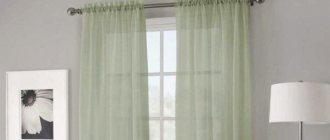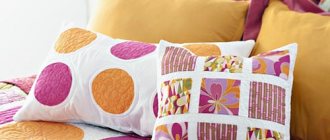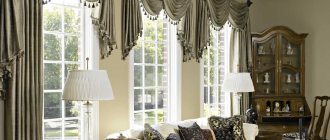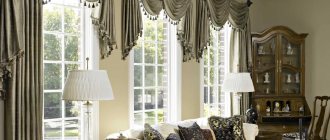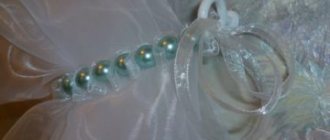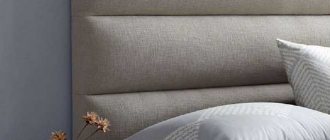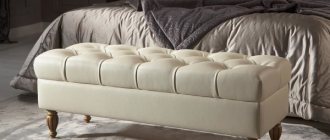This is something everyone thinks about if they want their living room, bedroom or any other room to be unusual in its design.
There are many options for creating draperies on fabrics , but the most popular are folds directly on the canvas, which can be bow, one-sided, glass, and all of them are usually done by hand. Therefore, you need to know the technique of creating them.
What is curtain tape
Curtain tape is a longitudinal braid that acts as a frame for draping curtains. Inside the tape, in special pockets, there are cords, the tension adjustment of which allows you to form decorative folds in the upper part of the curtains.
The technology of curtain draping is quite complex; without proper experience, it is almost impossible to give the fabric the desired appearance. Curtain tape greatly simplifies this process - when using it, you can create folds of any density and shape; moreover, any needlewoman can calculate and sew the tape to the fabric without any problems.
All braids on the market can be divided into the following groups:
The braids also differ in the number of gathering cords and compartments with hooks, the configuration of which determines the appearance of the formed folds.
The most popular are ribbons that create the following forms of drapery:
Pencil pleats can be assembled using the simplest tape with two cords without fixing hooks. All draperies of complex shape belong to the shaped category; for their formation, braids with a rather complex design are used, in which there are limiting hooks that prevent the fabric from straightening.
Awnings in the office
French curtains can create an image for the director's office, enliven the space of office furniture in the conference room, and add coziness to the school principal's reception area. They look good on wide windows. Therefore, awnings will be useful if the room periodically needs to be shaded for presentations on a projector.
It is better to prefer synthetic materials for curtains in work rooms - it retains its presentable appearance longer and collects less dust.
Assembly factor and its calculation
The curtain assembly coefficient is the ratio of the dimensions of the canvas and the curtain tape, on which the initial length of the braid required to form a certain type of drapery on the finished product depends.
The gather factor is determined based on the shape of the folds you want to achieve:
Separately, it is worth mentioning the gathering factor for curtains with grommets - it is 1.6-2.5. For draping curtains fixed with eyelets, a braid is used, the design of which differs from standard tapes - it has special holes for ring fastenings.
The higher the gather factor for curtains you use, the tighter the folds will be in relation to each other. The above coefficients are not mandatory; if desired, they can be increased by 0.5-1 and get thicker drapery.
We give an example of calculating the length of the braid for an Italian type curtain consisting of one sheet. The initial data is as follows: the length of the cornice is 3 meters, the coefficient for assembling Italian curtains with pencil folds is 2.5.
We take an additional 10 centimeters in reserve so that when attaching the braid to the canvas, we can tuck its edges inward.
The easiest DIY sewing option
You can sew French curtains quite quickly using these instructions. First you need to prepare the fabric, cut it, and overcast the edges. Further:
- mark the festoons at the same distance from each other;
- sew the braid along the marking lines;
- insert a cord into the seams along the edges, form folds;
- fasten the ends at the top, tie at the bottom;
- sew weights along the edges at the bottom.
You can make awnings for small windows using a master class in an hour or two. In the photo they do not differ from complex options.
Assembling curtain tape
The tools needed to assemble your curtain tape will depend on the type of tape you use. To attach self-adhesive tape, all you need is an iron and parchment paper, while regular tapes need to be attached using a sewing machine.
First of all, you need to assemble the fabric:
After the curtain is assembled, iron the fabric and begin tightening the braid and draping the curtain.
It is better to do this with an assistant, since it is quite difficult to evenly distribute the folds on a large canvas alone. If you're working alone, securing one end of the curtain to the doorknob will make the whole process much easier.
It is extremely important not to allow the tape to sag during operation, since after hanging the curtain on the curtain rod it will straighten and the resulting folds will be deformed.
To begin, fix one edge of the braid - on its sides there are strings for tightening, which need to be tied in such a way as to limit the movement of the fabric on the side of the fabric opposite you.
The folds on the curtain are created by shifting the fabric along the threads of the braid. During the draping process, due to the reduction in the width of the fabric, the side ropes will be exposed; wrap them on cardboard.
When the folds in the fabric begin to prevent its further movement, move the fabric towards the fixed edge of the tape. The degree of assembly increases until the curtain reaches the required width; it must be regularly checked during operation using a tape measure or meter.
How to lay one-sided models?
Laying one-sided assemblies is not very difficult. To do this you should:
- mark the fold and alignment lines, setting aside segments equal to the width of the fold (10 cm in the example);
- lay the first piece - take the fabric at the level of the third mark and pull it to the first, pin it together (line 2 will be inside the fold);
- move the fourth and pin at the level of the second and so on until the end of the material;
- after forming all the assemblies, they should be secured with machine stitching;
- treat the top with curtain tape, having previously pulled out the strings from it, or with decorative braid.
How to assemble curtains: using curtain tape and manually
The traditional version of curtains is sliding curtains with a tulle curtain underneath them. To make such curtains look attractive, they are made with folds, which create a drapery effect and allow you to beautifully lay out the curtain fabric. The folds are created by assembling the curtains.
Special tapes help create various folds, from simple to the most original.
You can assemble the curtains using a special curtain tape or manually.
The latter method provides more opportunities for various design solutions. The drapery can be made asymmetrical or one that will fully meet your design idea. However, in this case you will need to put in more effort, while curtain tape allows you to achieve a good result without difficulty.
Types and models of folds on curtains
What draping technique should I choose so that it can make the product the most striking in terms of design solutions?
In any case, we should not forget that any curtain will look neat if you correctly and competently calculate the depth of the fold of the fabric.
After all, the greater the number of deep folds used, the larger the footage of fabric required for sewing curtains.
Types of drapery
Folds on the canvas can have different appearances and be performed in different ways. Drapery can be one of the following types:
To create beautiful folds, the curtain tape should not move in different directions, but should be strong.
Any of these types of assembly can be done by hand or using curtain tape. It’s not difficult to assemble curtains using braid. Curtain tape, which is a closed structure with ropes inside, is sewn to the upper edge of the curtains. Built-in ropes allow you to create folds on the canvas; to do this, just pull the ropes. The folds must be distributed evenly throughout the entire fabric.
The only drawback of this design method is the low wear resistance of the curtain braid ropes. If the ropes break, the structure will have to be completely replaced, and this may affect the appearance of the upper part of the front side of the curtains.
How to choose colors
The color of curtains with folds can be chosen to suit your taste. The shade can be contrasting or combined with:
- design of walls, ceiling, floor;
- color of furniture facades;
- texture and shade of cornice for awning curtains;
- other textile elements.
A large print may be distorted due to folds; a small repeating pattern or a plain fabric is recommended. Tiny flowers, geometric patterns, and gold symbols look good.
Manual assembly method
Many people believe that only professionals can lay drapery by hand. However, it is not. This method of design is more reliable and durable, since the strings of the curtain tape can break. This method will require you to spend more time, but the results are worth it.
Before starting work, you need to calculate how much fabric you will need to decorate with drapery. Be sure to measure the length of the curtain rod with utmost care. This value also determines the length of the curtains. The resulting value must be divided by the number of folds that you plan to lay. As a result, you will get the distance between them. It is not recommended to take it larger than 10-14 cm. The optimal assembly depth is 14-20 cm.
The selected depth must be multiplied by their number, add to the result the length of the cornice and 2-4 cm of reserve, which will be used to process the curtains on the sides. If a curtain tape is sewn onto the curtain, and you assemble it manually, then the strings from the tape need to be removed, since in this case they will only get in the way.
When the material is prepared, you need to hem it at the folds in the upper part of the fabric. This can be done manually with a needle and thread or using a machine. Select threads so that they are not visible on the fabric. Additionally, the curtains can be decorated with buttons in matching or contrasting colors, depending on your idea.
Thus, you can now assemble the curtains yourself in a way that seems more convenient and practical to you. In any case, the work must be done carefully so as not to damage the canvas. Before performing it, pay attention to calculating the required amount of fabric. Drapery curtains will look appropriate in any interior; you can independently determine its thickness depending on your preferences and the overall interior of the room.
Source
How to create bow folds?
In bow versions, the fold lines are located at the back. The central part (bow) is located on the face of the curtain, and the folds are connected on the wrong side.
When marking bow pleats, it is important to always start with a value of c. In the future, this distance is not laid down, but is wrapped on the opposite side. Next, you should make the markings according to the calculation (for continuous ones, 10 cm, for the option with intervals, 7.5 cm each). For greater convenience in the latter case, it is better to mark the gaps with colored chalk or a felt-tip pen.
After applying the markings, you can begin decorating. For solid model:
- lay the first bow - move the fabric at the level of the first mark to the beginning of the fabric, and align mark 2 with 3 and pin it. In this case, the fold lines should meet in the center of the bow. After this, the extreme bend can be released;
- second bow - combine mark 4 with 3, and 6 with 5. Pin both folds;
- continue until the end of the fabric;
- stitch and finish the top.
For the spaced option, the first bow is formed as described above. For the second bow: combine mark 5 with 4, and pull 7 to 6. Pin and similarly form the remaining bows and process the top of the curtain.
How to curtain a window with tulle and how many meters are needed for a 3 meter window
Correctly chosen textiles help create a complete image of a room and completely change its appearance. If you curtain the windows with tulle, you can visually expand a small room, hide defects in window sills and slopes, and create additional transitions from light to shadow. The fabric is universal, practical (washing it does not cause problems, it does not wrinkle), therefore it is often used by designers when decorating houses and apartments, regardless of style.
Fabrics from which these curtains are made
Sewing French curtains involves the use of natural, synthetic materials. Read more about popular fabrics below.
Linen
For awnings, natural linen or material with synthetic additives is suitable. Linen is environmentally friendly, wear-resistant, and hypoallergenic. The disadvantages of the material are fading and drying out. Linen wrinkles quickly and loses color.
Velvet
Suitable for decorating windows with balcony doors, living rooms, bedrooms, theater stages. It drapes, shimmers softly, looks luxurious, and is popular for French curtains. Recommended for spacious rooms; finished curtains have significant weight.
Veil
Translucent fabric, made in the form of a mesh or ruffle, is ideal for sewing French curtains. It perfectly collects, diffuses light, and transforms the interior. Doesn't shine, hides what's happening in the house. It gets dirty quickly, accumulates static electricity, and breaks easily.
Silk
Curtains with silk pleats look aesthetically pleasing, allow air to pass through, do not cause allergies, and are environmentally friendly. It has high drapability, therefore it is recommended for sewing French curtains. The fabric requires difficult care and is expensive.
Organza
Shiny translucent material that forms graceful folds. Suitable for sewing French curtains for the kitchen or dining room: easy to wash and dry quickly. Does not block the sun's rays and does not shade the room.
Satin fabric
Forms beautiful shiny folds, used when sewing awning curtains for rooms in a classic style, art deco, Provence. Looks great, drape great. Expensive and requires difficult care.
Types of tulle assembly
The peculiarity of tulle curtains is the need to form neat folds. Depending on their number, shape, density, the width of the canvas can be 1.5-3 times larger than the window opening. To keep the drapery neat, a white or transparent ribbon is sewn along the top on the reverse side, which has ready-made loops for attaching to the cornice.
It is also possible to use other assembly methods:
Decorative fastenings can completely transform the look of a curtain: rings, clips. Clothespins are often used as fasteners - in the form of bows, butterflies, flowers.
For a window in a children's room, manufacturers produce products in the shape of suns and teddy bears. This decor will become a spectacular accent in the interior. The photos presented in the catalogs of fittings manufacturers reflect how much these details influence the overall appearance of the curtains. However, they can be replaced without difficulty.
Curtain care
Washing and ironing curtains with pleats is difficult. Curtain care involves:
- removing curtains from cornice boards;
- neat straightening of the fabric by pulling the threads;
- washing in accordance with the mode suitable for the selected type of fabric;
- ironing at low temperatures.
It is better to replace ironing with steaming, and washing with dry cleaning. In this case, the curtains will remain lush for a long time, and the festoons will remain neat. Do not wash the product in a machine. It is better to combine soaking and manual care.
Assembly size
The length of the tulle depends on the length of the cornice (standardly it protrudes 15 cm beyond the window opening) and the method of draping. Based on these parameters, the filling coefficient (density) is determined. It shows how many times the canvas is larger in size than the structure on which it is attached. The minimum indicator is 1.5, the maximum is 3.
When calculating, the density of the tulle is taken into account. If the material is thin and you can clearly see your hand through it, we buy a canvas with a filling ratio of 1:2 or higher, taking into account the type of assembly. At higher densities, this parameter can be reduced to 1:1.5.
It is also worth calculating the density of the assembly based on the method of fastening. When using curtain tape, this parameter is indicated by the manufacturer on its packaging.
The average figure, which is suitable for almost any selected window decoration option, is 1:2.5. When determining the width of the fabric, it is worth taking into account allowances for the formation of side seams on both sides of 3 cm.
To choose the right gathering density, take into account the presence of patterns on the fabric. The rule applies: the larger the pattern, the less filling the window should be curtained with.
Awnings in the hall
Windows and balcony openings in the hall and living room provide the greatest scope for creative imagination. Here you can place wide awnings made of light tulle, frame them with curtains, and hang cascading curtains from several layers.
The color scheme can be any. And restrained pastel colors, and luxurious gold or scarlet, and original bright shades.
Note!
- Light green curtains - 120 photos of the most beautiful design and interior design options
- Ready-made curtains - how not to make a mistake with your choice? TOP 100 photos of the best new designs
Japanese curtains in the interior: bedrooms, kitchens, living rooms. 90 photos of the best new designs
It is good to decorate wide curtains with a lambrequin, and tie the curtains with a cord with tassels or ribbons. The main thing is that the curtains fit into the overall concept of the interior.
How to calculate tulle according to the cornice
The room does not always have a rectangular shape, and the window opening is a standard design. If the façade of a building has a projection with windows (their number can be from 2 to 5), it is called a bay window. To drape such openings, curtains are used and cornices of appropriate shape are installed. Selecting their sizes can be challenging. The technology for determining them depends on the shape of the rod. The following types of fastening structures are available:
If the bay window has a large area, it is possible to install cornices of any configuration.
For angular protrusions, it is recommended to choose simple models. Mount a large solid structure or a group of short ones.
Awnings in the bedroom
Experts often recommend leaving only the minimum necessary things in the bedroom - a bed, a bedside table with lighting and wardrobes (if necessary). Any equipment or objects that can distract and disrupt sleep should be eliminated.
As a result, the bedroom may end up “empty”. Lush awnings can fill this void, give the room a complete and cozy look, and set the mood for rest and relaxation.
For a bedroom, awnings can be long, reaching to the floor. The choice of fabrics is large and depends on the size of the room. For small rooms - light fabrics, for large ones - heavier ones.
Selecting curtain sizes
The width of the curtains is determined by the size of the rod and the method of assembling the fabric into folds, on which the fill factor depends. To determine the length of the tulle, take into account the features and purpose of the room. In the kitchen or children's room, for safety reasons, curtains often only reach the window sill. In living rooms and bedrooms, they are hung to the floor (the gap is 1-1.5 cm) or spread across it in beautiful waves. If there is a bed, desk, or other furniture near the window, the assembly can also be done from below the canvas, creating an additional decorative effect.
Length adjustments may be necessary after changing the use of a room or rearranging furniture. To do this, you can use several methods for reducing the fabric without trimming: use magnetic grabs, assemble manually with threads, and make seams with vertical tightening. All measurements are carried out after installation of the cornice, because it can be located at different heights in relation to the window opening. Take into account the distances from the walls for the heating radiator.
If the curtain design provides for a length to the window sill, the bottom line of the curtain should be 1 cm higher. Due to this, the curtain will move without obstacles and will allow you to easily open the shutters. This option is more often used in the kitchen, in the nursery, on the loggia due to functionality and safety. Medium-length tulle curtains are also often hung here. They overlap the window sill level by 12-15 cm, which opens up more possibilities for choosing the drapery method.
What is a French curtain
The second name for curtains is “awning”. Perhaps they got it for the lush scalloped folds, reminiscent of the skirts of the ball gowns of the court nobility. Lush horizontal festoons cover the entire panel. This differs from the awning from the Austrian curtain, which is decorated with waves only from below. The lower part can be decorated with beads and fringe.
Curtains can be equipped with a lifting mechanism similar to those found in blinds. Thanks to this, the canvas can rise and fall, changing its length. This is very convenient if you plan to open the window or if the model is made of thick textiles. Light transparent curtains are often sewn static, without a lifting mechanism. They completely cover the window or reach the floor. Sometimes they are combined with thick curtains. They look good in kitchens, as in the photo, or in living rooms.
Instagram @art_shtora
Instagram @art_shtora
- Cleaning
How to wash curtains: instructions for hand and machine washing
Solutions with short curtains
Short French curtains are most practical for kitchen window openings.
Due to their lush structure, they look complete, despite their length. Do you want French curtains for your kitchen?
Yes, it’s very beautiful Yes, of course, it looks good and is easy to wash, you just need to choose the right material No, it’s too expensive No, it’s too difficult to care for
Warm comfort
A short transparent awning, which does not reach the window sill, easily envelops the window, masking the room from prying eyes. The light combination of warm tones of curtains and blinds creates a cozy feeling of intimacy. In such a kitchen it is pleasant to drink your morning coffee without taking off your soft robe.
Light clouds
Airy festoons easily decorate the window opening, softly dimming the street light. A creamy translucent curtain gently accentuates the white elegance of the cabinets and gilded handles.
Strict luxury
The clear wave of the awning slightly covers the strict lines of the windows. The wide, bold balcony opening is softened by soft waves of fabric. This spacious kitchen exudes a feeling of stability and peace.
Luxurious gold
An opaque short curtain in creme brulee color, decorated with gold fringe, looks harmonious with gold ornaments on the furniture and enhances the feeling of luxury. An excellent option for a spacious dining area.
Strict classic
The simple, clear lines of the wide window opening and the strict geometry of the ceiling are emphasized by the graceful waves of a transparent awning, combined with long curtains. A horizontal dark stripe on the side curtains gives the dining room a mirror effect.
Effortless Simplicity
White and taupe are the perfect simplicity. A transparent awning, harmoniously combined with dark lambrequins, gives the kitchen a casual feel. An ideal corner for an armchair, a book and a glass of red wine.
Air space
Flying awnings on long narrow windows expand the space due to the soft light tone of the fabric and lush structure. Narrow windows visually look wider, and sufficient height allows you to expand the space upward.
Elegant practicality
A short awning with a tint that goes from creme brulee to baked milk allows you to use the entire countertop space for cooking. The bottom of the curtain is enlivened by contrasting fringe.
Honey light
The combination of gold and baked milk fills the kitchen with a soft honey light. French curtains, complemented by richly patterned drapes, bring warmth and comfort to the luxurious dining area.
Required skill level
Awning curtains differ from each other not only in color, method of fastening and static, but also in the shape of scallops (falling folds). For example, if dense and heavy fabric is used for tailoring, the tails will have a rounded appearance and a large degree of sagging. Lightweight and well-kept fabric will help create lush, low-sagging scallops.
It is not difficult to sew this type of window draperies, however, it is better for a novice craftswoman (master) to opt for a static version, which will not rise or fall, but will perform a purely decorative function.
aura_home_com
assem_nurlybayeva
What do you need to buy besides fabric?
In addition to the fabric for sewing curtains, other materials are also needed. First of all, you need to select threads that match the color of the selected material. You need a lot of thread, so you should choose either a large bobbin, or (if one is not available) buy several spools at once.
In addition to the thread, you will also need a braid with which the curtain is attached to the cornice. Its length coincides with the width of the curtain. When buying this braid, you cannot focus on the length of the cornice, since the width of the panel is greater than the window opening.
You also need to purchase a special braid for drapery. It is with the help of it that the side lines of the fabric will be pulled together. You can calculate the length of the required braid using the formula:
= scallops + 1 (for assembling the outer scallop) * for the length of the panel intended for sewing curtains.
In addition to materials, for sewing French curtains you also need:
- sewing machine;
- pins;
- scissors;
- as well as soap or chalk (for cutting).
How to prepare fabric for cutting
Before cutting and sewing the curtain, you must trim its edges, using a special braid to secure the curtain. The side and bottom edges simply need to be folded in half and stitched, then pressed. The edges need to be processed before sewing the curtains, since then they will be uneven and cannot be processed beautifully.
It is also necessary to iron all the material before starting sewing, and if it is difficult to iron, then this should be done two or three times. After sewing the curtain, it will not be possible to iron it, so this stage cannot be neglected, but it must be done efficiently. When the edges of the canvas have been processed and it is completely ironed, you can start cutting.
Methods for folding folds
Before calculating the amount of fabric needed to sew curtains, you need:
- Take an accurate measurement of the length of the cornice.
- Determine how the side edges will be processed.
- Calculate the depth of the folds taking into account the type of fabric chosen.
Manually
The fabric of the future curtain can be draped manually. In this case, it is necessary to carefully calculate the fabric consumption and the required tape footage for forming tucks.
There are difficulties with this sewing method. All the ropes have to be pulled by hand. In this case, they wear out much faster. If they tear, the entire drapery will have to be restored at once.
Using tape attached to the top of the fabric
Most often, simple folds are created using braid. In this case, it is necessary to take into account the allowance for the tape. More complex designs may require 3 to 4 rows of tape.
The most convenient options for tapes are adhesive ones.
They do not require sewing, but are connected to the fabric when ironed.
Fabric preparation and processing
Sequencing:
- The first step is decating the fabric (its wet-heat treatment). This measure will eliminate the possibility of shrinkage during operation or after the first wash.
- The second step is to find and iron the center of the narrow fabrics (from which the curtain will be sewn).
If the window drapery is sewn from a whole piece of fabric, then, armed with a sewing meter and chalk, you will need to find the lines for ironing yourself. To do this, the material is spread on a flat surface, 5-10 cm is removed from the side, and the entire remaining cut is divided into an odd number of strips (3, 5 or 7 pieces):
- 175 cm - 20 cm (distance from both sides) = 165 cm;
- 165 cm / 5 = 33 cm (width of one strip).
The left and right edges of each resulting strip are the line that needs to be ironed.
Sewing curtains with eyelets
Master Class. We compare the cost of finished products and hand-sewn ones
Instructions
More details
How to sew Roman blinds
Step-by-step instructions for beginners and intermediates
Instructions
More details
How to make thread curtains yourself
Step-by-step master class. How much does it cost to make a curtain with your own hands?
Instructions
More details
DIY roller blinds
Step-by-step instructions for making roller blinds
Instructions
More details
Pleated curtain design
The main source of good mood is tastefully designed and sewn products.
At first glance, it may seem that there is nothing complicated about this: there is fabric, there are two hands, but on top of everything else you still need desire, skill and a little imagination, without which it is impossible to create anything original.
The density of the fabric, its texture and color scheme dictate what assembly technique can be used in a particular case, and if it is dense but soft material, then volumetric folds such as bows, glasses, and one-sided ones will look great on it. You can learn more about matching the color of curtains to the tone of the wallpaper in this article.
Disadvantages and advantages
Seeing the magnificence of “marquises” for the first time, one involuntarily thinks about practicality
You will have to take great care in caring for the elegant “French lady”. An awkward movement can easily damage the cascade of tulle folds, not knowing that they are not designed for curtains
The stunning beauty of the veil compensates for the difficulties of care:
- look presentable;
- lush folds slightly shade the room, the lifting mechanism regulates the flow of sunlight;
- the movable structure provides access to window sills, vents, and balcony doors;
- “French” is in harmony with lambrequins, decor, day/night curtains;
- high variability of style, mounting methods on windows of different shapes.
Among the disadvantages they mention problematic washing and costs for curtains “as in the picture” (a lot of fabric, sewing in a studio).
When switching to a different design, it is difficult to find a worthy use for old curtains with scallops. They have no place in a wooden country house or on a narrow balcony with panoramic glazing.
Creating a masterpiece for your home
Fabrics for French splendor
French curtains
To make curtains you need thin, expensive fabric that can be easily draped into beautiful, elegant folds. Most often, for expensive models they use silk and cambric fabric, as well as similar materials. Such a curtain made of transparent tulle is good, although the classic version uses silk with a shimmer, like satin. Organza is also used as a material, only it must be elastic and form delicate folds without puffing up. The beautiful transparent fabrics in the photo, stunning pastel colors, cannot leave even lovers of strict style indifferent.
Modern materials allow you to create modifications of all desired shades that are easy to care for. For example, polyester fits into drapery no worse than silk, and also does not shrink when washed and does not fade in the sun.
Sewing French curtains
Simple versions of the awning can be sewn if you have good sewing skills. However, the real masterpieces shown in the photo are created and modeled in specialized salons. It is necessary to choose the right texture and color of the fabric so that the curtains fit harmoniously into the interior, complementing it. In addition, these curtains simply require additions in the form of curtains, lambrequins, decorative tassels and other elements
It is very important to correctly calculate the number and range between the sections that form the drapery - scallops, and sew in a braid for gathering or a drawstring. Working with delicate, expensive fabrics requires skill, and such a curtain cannot be cheap, but the result exceeds all expectations
Roller of French curtains
Calculation of fabric for French curtains
As shown in the photo, the curtains are gathered not horizontally, but vertically. This is the basis for the calculation of the required fabric for them. Typically, the width of the curtain is made equal to the length of the cornice or a little extra width is provided for horizontal assembly along the cornice. But the length of the fabric should be much greater than the length of the finished curtain - no less than 1.5 times, and in some cases 2.5 times. It all depends on the design concept and the fabric taken for sewing. The standard fabric calculation is as follows:
- The width of the cut is calculated according to the length of the cornice, adding 5 cm for finishing the edges. And if you want to gather the curtain in width, then take the width multiplied by the coefficient of the desired assembly;
- the length of the cut is equal to the desired length of the curtain, multiplied by 2, with the addition of 10 centimeters for processing the bottom hem and top.
Drapery
The French model differs from the others in its drapery method. Semicircular folds along the entire length of the curtain are made using a narrow braid, the length of which can be calculated from the height of the curtains. The cut height of the curtain must be multiplied by the number of scallops that are planned on the curtain, and also add another cut height to the resulting number. In the photo you can see that the drapery does not always go along the entire length of the fabric; sometimes only the bottom or half of the total length is draped. Then the calculation of the length of the fabric and braid will be different.
The distance between the festoons, which form a wavy drapery in slender rows, should be about 50-60 cm. The number of such festoons is very easy to calculate if you divide the width of the fabric by the distance between them. In addition, there are special calculation schemes.
On the wrong side you need to mark the place where the gathering tape will be sewn. With the fabric right side down, pin the braid, the bottom 2-2.5 cm need to be folded. The cord from the braid needs to be pulled out from under the bend in order to use it to regulate the assemblies. Having attached the braid, you need to bend and stitch the bottom edge of the curtain. All that remains is to adjust the drapery and secure the ends of the cords. The top edge of the finished product should be attached to the cornice, and it should be reinforced with rigid tape.
To prevent the fabric from mowing or pulling in the future, it is advisable to wash the fabric in warm water and dry it before sewing. After the procedure, it will be more stable and reliable to use.
We sew curtains ourselves
You can make cylindrical folds on curtains yourself, the main thing is to buy braid and prepare thoroughly. If the operation is carried out exclusively by hand, then you will simply have to pull the strings sewn into the tape, but they quickly wear out and require replacement. And if the lace breaks somewhere in the middle, then you will have to completely rip out the top of the curtain.
Step by step instructions
First you need to calculate the folds for cascading Roman blinds. In addition, here you will need to calculate the dimensions from ceiling to floor, the width of the cornice. You also need to take into account the number of windows on which there will be curtains with drapery. If the fold depth is required within 15 cm, then initially you need to sew at least 10 cm with tape. When making initial calculations, you should add an extra 3-5 centimeters so as not to make mistakes with the fabric, otherwise there may not be enough for full folds.
After the fabric is ready, you should move on to creating high-quality drapery. To do this, a ribbon is sewn on, this is how a manual fold is made on the curtains. Before this, you need to remove protruding threads and laces; there is a special technology, but this is done by hand. Of course, if you have the skills to use a sewing machine and the seams come out smooth, then you can seriously make your work easier.
What you need to do the work
Regardless of what kind of drapery and type is required, certain tools and devices are always required:
Curtain fabric
- Curtain fabric;
- Tape, taking into account the type and quality of the material;
- Needles;
- Threads;
- Sewing machine.
When you first come to the store, taking into account the fact that you are planning to make folds on tulle curtains, immediately take fabric with a reserve. In order for the view to be beautiful and the curtains to cover the window, the calculation must be done as follows: multiply the desired number of folds by the depth. The resulting number should be added to the width of the curtain, which should cover the window as it is already completed. Well, plus small side hems, they require 2.5 cm on each side. The length from the bottom to the cornice does not change at all, here you only need to make an adjustment for the upper and lower processing.
Before beautifully laying folds on the curtains, smooth fabric, canvas, should be well processed.
The threads should be removed, the lacing should be tied, and the edges should be processed and stitched. This is best done on a sewing machine; doing it by hand will take too much time. Before stitching, it is advisable to practice on a scrap of fabric that you don’t mind.
Most of those who design curtains professionally do it by hand. When the fabric is sewn independently, the stitching of the fabric is tighter and the destruction of such an assembly is less likely. In this case, the labor intensity increases significantly, but this pays off due to the growing reliability of the fabric - if you pull a hanging curtain that is sewn on a machine, the colloquial line will remain on the cornice, and the curtain will remain in your hand.

